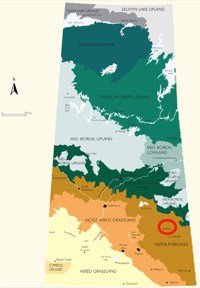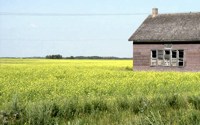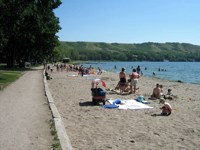Yorkton
Community Assessment & Adaptation Options:
Yorkton is located in east-central Saskatchewan along the Yellowhead Highway within the Aspen Parkland Ecoregion. Yorkton is the largest city in eastern Saskatchewan and its economy is closely linked to the surrounding agricultural and tourist landscape. Yorkton is a major service centre, farm implement manufacturer and food processor. Park and tourist attractions in the area include the Yorkton Film Festival, Western Development Museum, GoodSpirit Lake and Duck Mountain Provincial Parks and several regional parks.
The Aspen Parkland Ecoregion encompasses a mix of aspen forest and fescue grasslands. It is a transition ecoregion, between continuous grassland areas further south and continuous forest cover further north. The ecoregion is dominated by agriculture, being approximately 80% cultivated (Figure 2). Several other urban centres are found within the ecoregion including Lloydminster, North Battleford and Melville. Several prominent upland areas are found. The ecoregion also includes major river valleys: the Souris, Qu'Appelle, Assiniboine, South and North Saskatchewan and Battle Rivers, and lakes including the Qu'Appelle lakes (Figure 3), Kenosee, Jackfish, Manitou and Lac Lenore. Numerous dams and reservoirs are present. Other economic activity includes heavy oil upgrading and potash refining. Outdoor recreation activity - hunting, camping and fishing - occurs throughout the ecoregion.
Climate Normals (1971-2000)
- The average daily temperature ranges from -17.9°C in January to 17.8°C in July with 5 months being below 0 (November to March). The lowest average daily minimum temperature is -23.2°C experienced in January and the highest average daily maximum temperature of 24.3°C is experienced in August.
- The annual precipitation is about 450.9 mm of which 77% is rainfall and the remainder is snow. 33% falls in the months of April, May, June, July.
- The average monthly wind speed is between 12.6 (August) and 15.9 km/hr (May)
- An indication of the demand for cooling and heating is provided by the number of degree days above 18°C - 94.6; and the number of degree days below 18°C - 6066.
- There are a total of 2330 sunshine hours per year with a minimum of 21.2 days with measurable sunshine in November and over 30 days in July.
Future Climate
Over the century to 2100 climate scenarios suggest:
- A warmer climate - temperatures may generally rise 2 to 4 degrees.
- A longer growing season - but drier, despite a slight increase in precipitation to just over 450 to 510 mm. This is a result of increased temperatures and evapotranspiration.
- The demand for summer cooling could increase 1.5 to 2.5 times.
- A shorter, milder winter. Heating requirements may be reduced by 14% to 31%.
- Expect more frequent and more intense extreme events (e.g. heavy precipitation or drought). Droughts will likely increase in intensity and frequency.
Regional Adaptation Options
- Under climate change, the primary issue for communities, agriculture and other economic activities will be water and sewer management to handle both flood and drought situations.
- Xeriscaping (low water landscaping) and other water conservation measures should be priorities. Notwithstanding, the Yorkton area is less vulnerable to drought than areas to the west.
- Soil and moisture conservation should continue to be an agricultural priority.
- Native habitat can be expected to adapt to drier conditions, including changes in species composition. Stocking rates and/or grazing periods may have to be adjusted.
- A longer summer season is a tourism opportunity.
Sources:
- Acton, D.F., Padbury,G.A., Stushnoff,C.T. (1998): The Ecoregions of Saskatchewan. Canadian Plains Research Center, University of Regina and Saskatchewan, Environment and Resource Management.
- Barrow, E. (2009b): Climate Scenarios for Saskatchewan. PARC Summary Document No. 09-01, 15p.
- Barrow, E. (2009a): Climate Scenarios for Saskatchewan. PARC, 131 p.
- Canadian Plains Research Centre (2005): Encyclopedia of Saskatchewan, Ecozones and Ecoregions.
- Environment Canada (2010): National Climate Data and Information Archive, Canadian Climate Normals website; station ID: 3062, Yorkton
- Saskatchewan (2010): Saskbiz, Community Profiles: Yorkton


